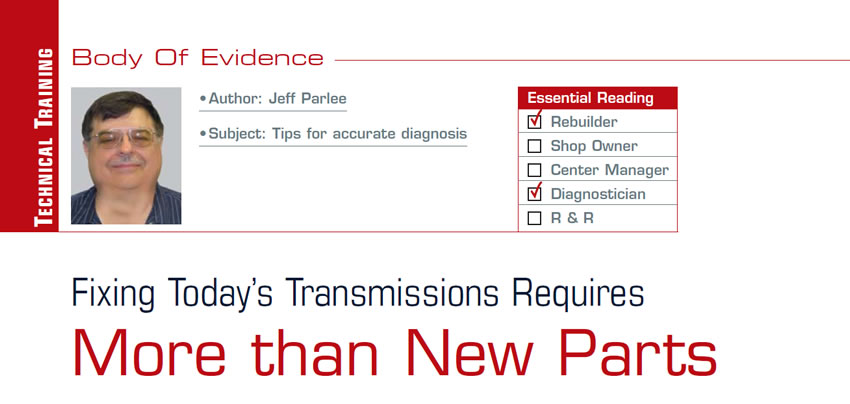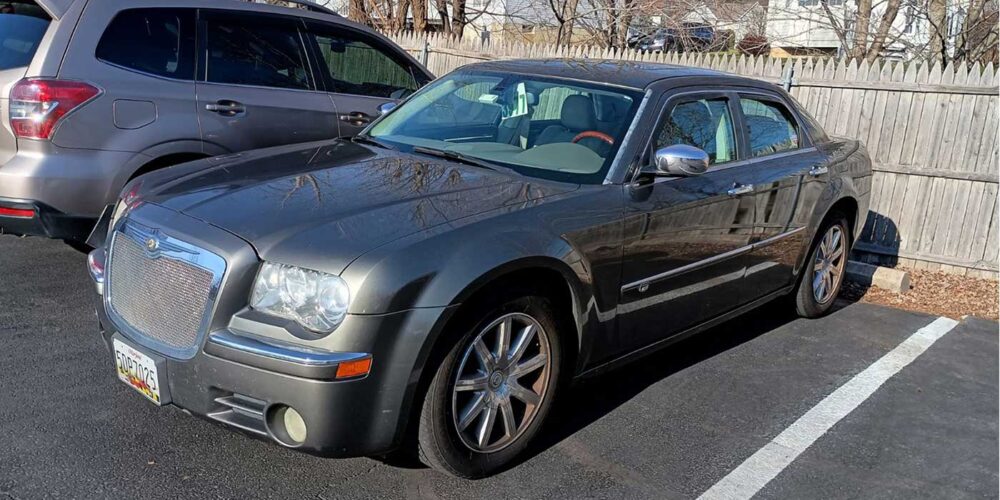
Body of Evidence
- Author: Jeff Parlee
- Subject: Tips for accurate diagnosis
- Essential Reading: Rebuilder, Diagnostician
It wasn’t too many years ago that when you got a vehicle in for a slip or flare the transmission was pulled and rebuilt. When installed it road-tested fine and down the road it went. There were no computers or sensors; there were T.V. cables, vacuum modulators and governors.
Times and cars have changed. Today there are so many things outside of the transmission that can cause transmission problems. You must be sure that your diagnosis leads you to the transmission before pulling that transmission out, especially a front-wheel drive. The last thing you need is to pull the transmission and find nothing wrong inside.
First, verify the customer’s complaint; remember that they may not be experiencing a transmission problem. Next, check for bulletins that relate to your problem and computer-software updates that may fix your problem. Doing this research takes only a few minutes but can save you a lot of time.
Remember that all the computer systems work together. The engine control module and even the brake control module can have an effect on the transmission operation. Don’t be fooled into thinking that only TCM trouble codes can cause transmission concerns. Always hook up your scan tool and record any trouble codes. Check for any freeze-frame data to give you any clues as to why the code set. Do not assume that because there are no check engine or check transmission lights on that you have no codes. Many codes do not trigger a warning light.
Look up any codes that you may get to see what kind of code it is and how it sets. Knowing how the code sets can give you some insight into what may be causing the code. The definition that the scan tool gives you will be brief and may not give you the information that you need to fully understand the code.
Be aware that some sensors may be sending bad information to the computers yet not setting a code. For example, speed sensors can become erratic yet set no code. If the computer uses that speed sensor to determine torque-converter-clutch slip, lockup-slip codes could develop. Mass-air-flow (MAF) sensors usually will not set a code unless there is an electrical failure; as long as there is a flow of information, good or bad, there will be no code set. I have seen lockup problems and low line-pressure rise commanded because of bad or dirty MAF sensors.
On many cars, the computer’s No. 1 priority is to keep the engine running as cleanly as possible. That means that the engine computer is always calculating what the MAF numbers should be by using other engine sensors. When the engine computer sees that the actual numbers are not matching the calculated number, it will start to use the calculated number to run the engine and post the calculated number on the scan-tool data. When this happens, the actual MAF numbers are still being used for the transmission.
I once had a Ford Crown Victoria with an AODE that had no lockup command. All the data looked fine – TPS, MAF, temperature sensors, MLPS – and no codes were present. I started to test each sensor individually and found that the MAF sensor was stuck at 2.0 volts all the time, regardless of the engine load. After I replaced the MAF sensor, lockup started to work again. The moral of the story: Don’t trust your scan-tool data; before replacing any part always verify the data with a multimeter or lab scope.
The most-important thing to understand is how the system on your vehicle works and how the trouble code sets or what the computer is looking at to set the code. Understanding these things will help you to home in on the correct diagnosis.

Jeff Parlee is director of product support at ValveBody Xpress.













